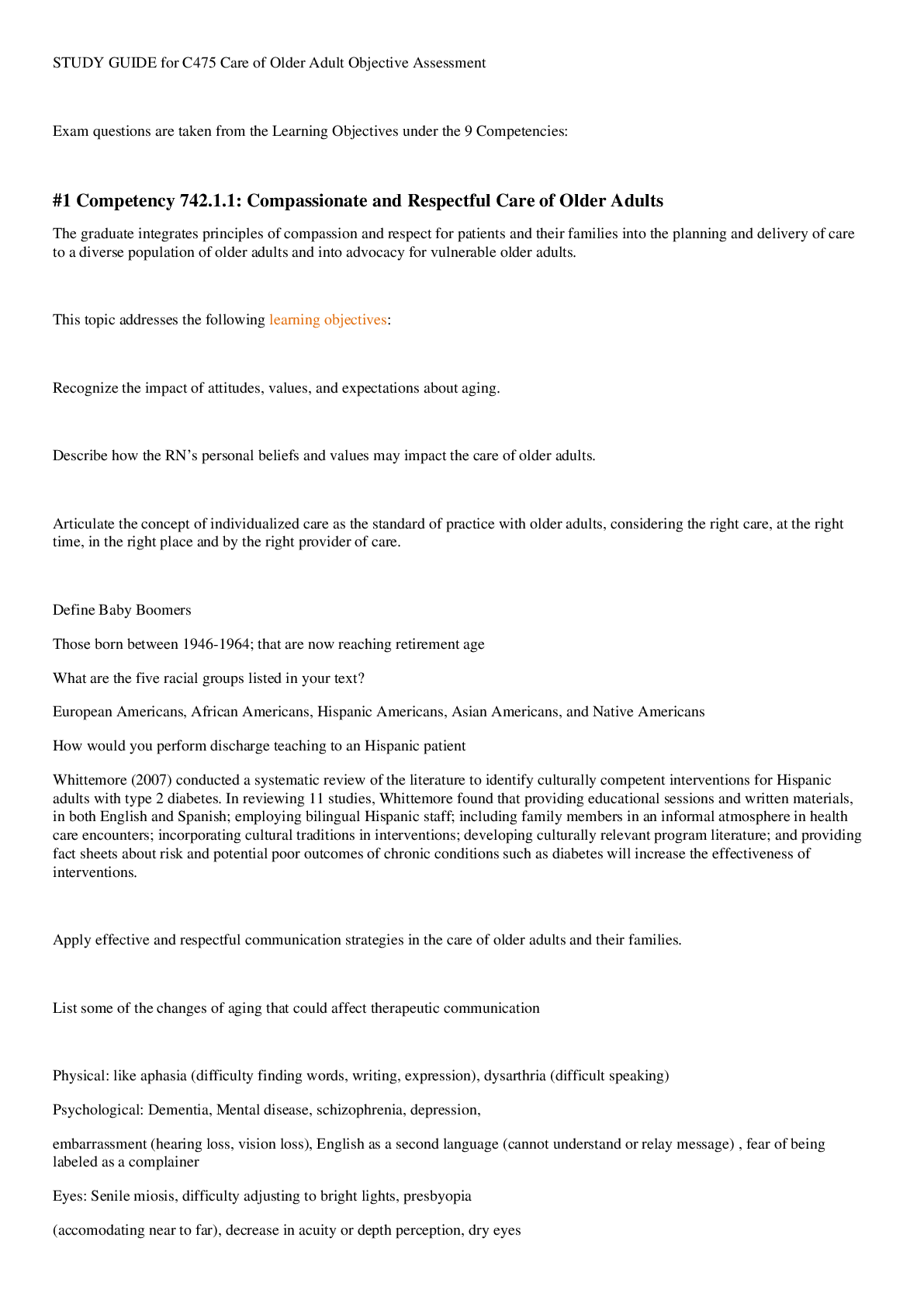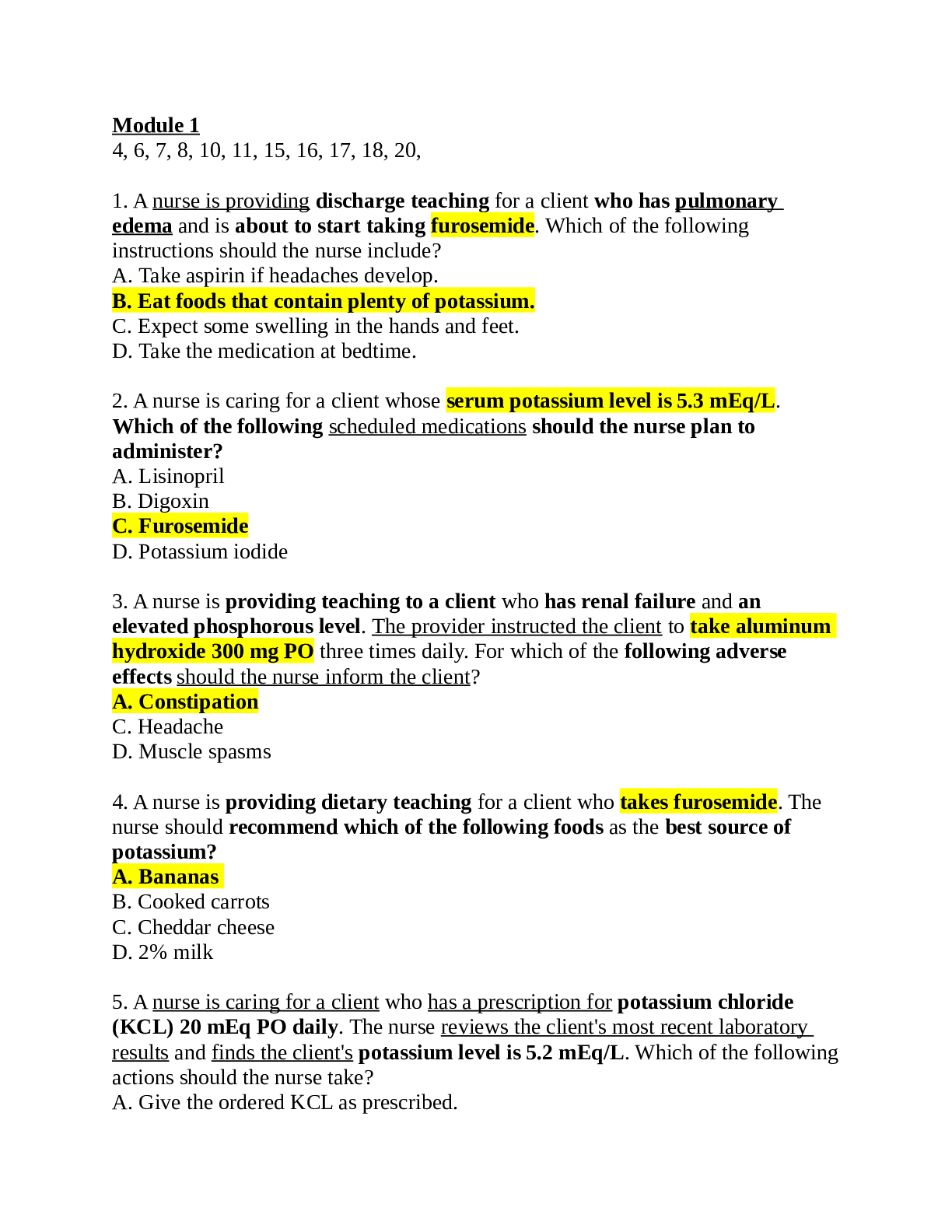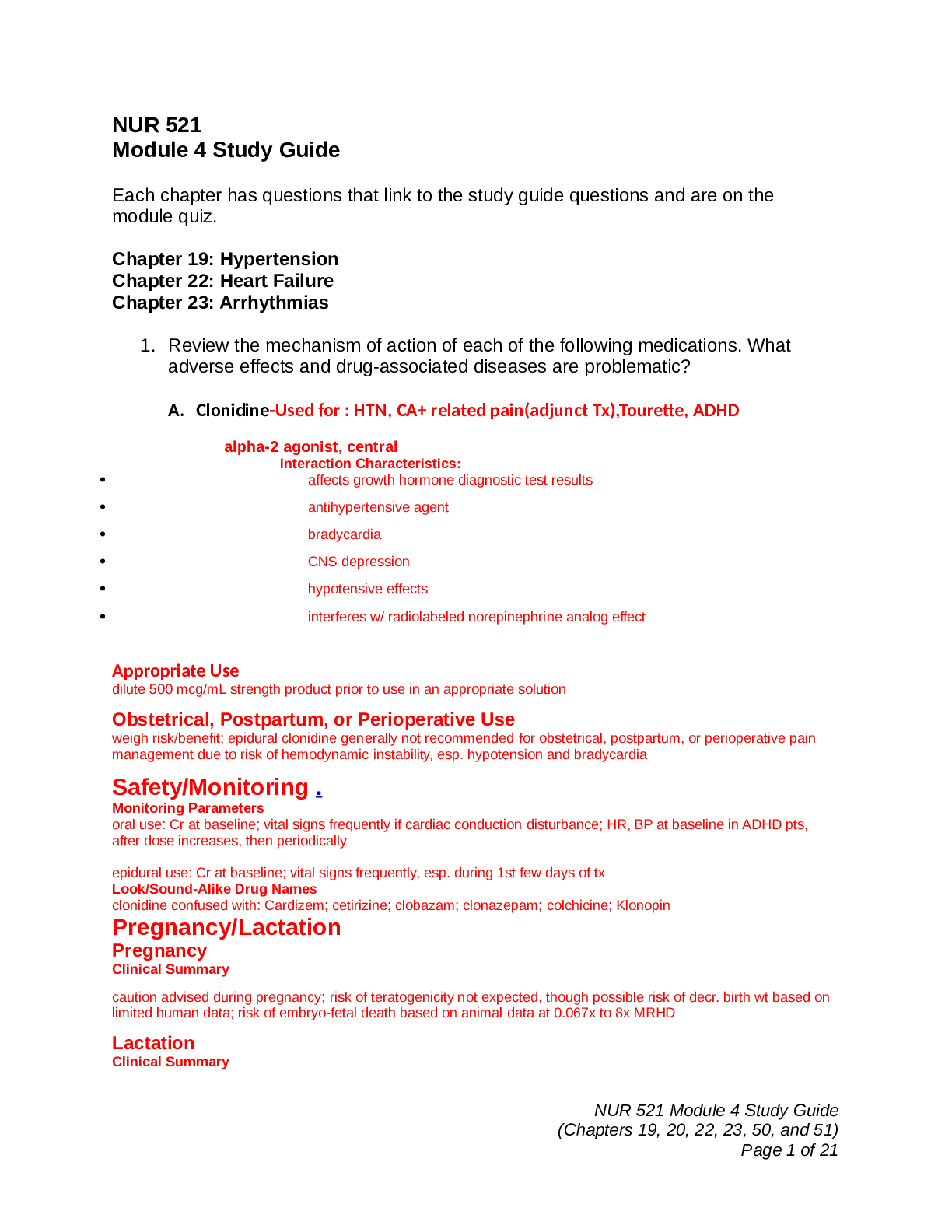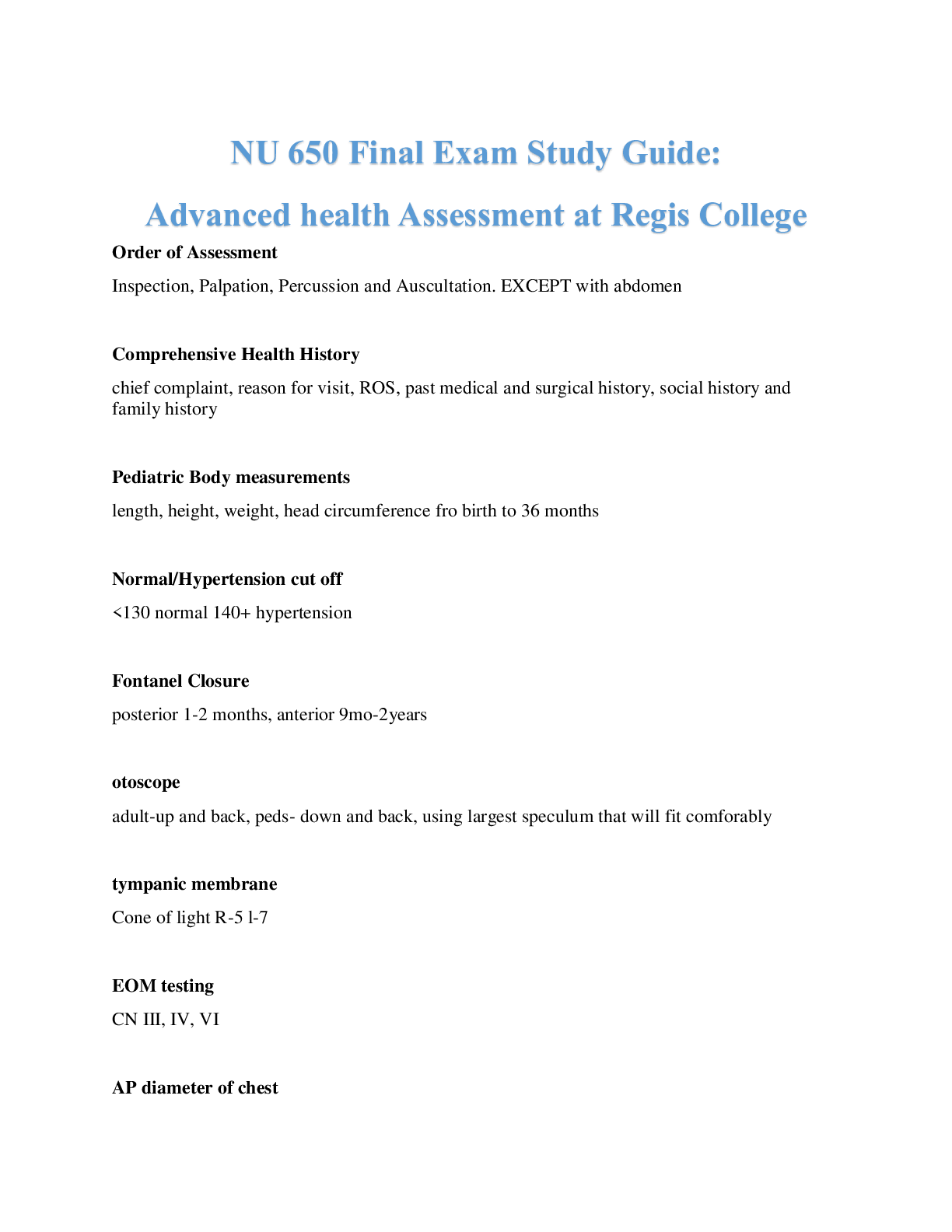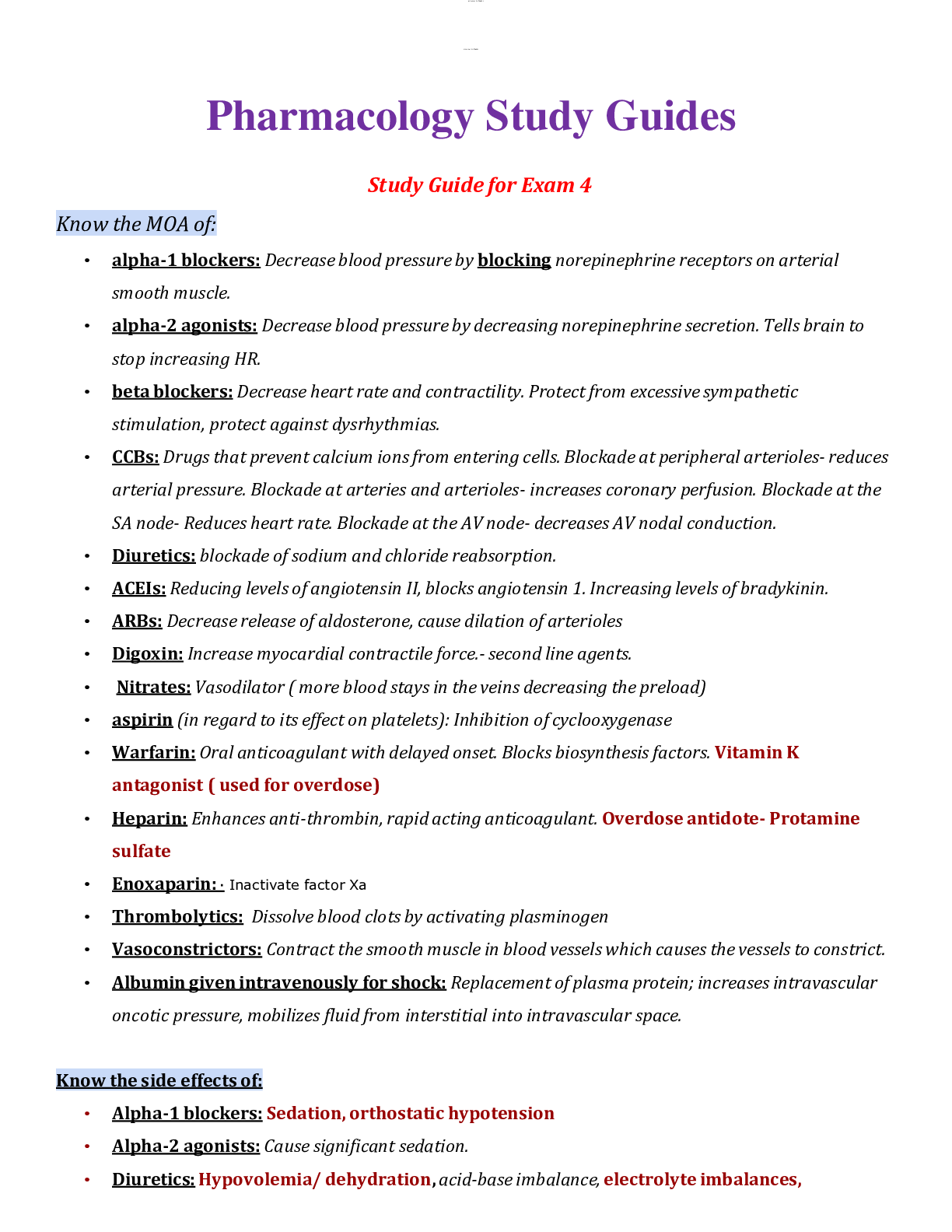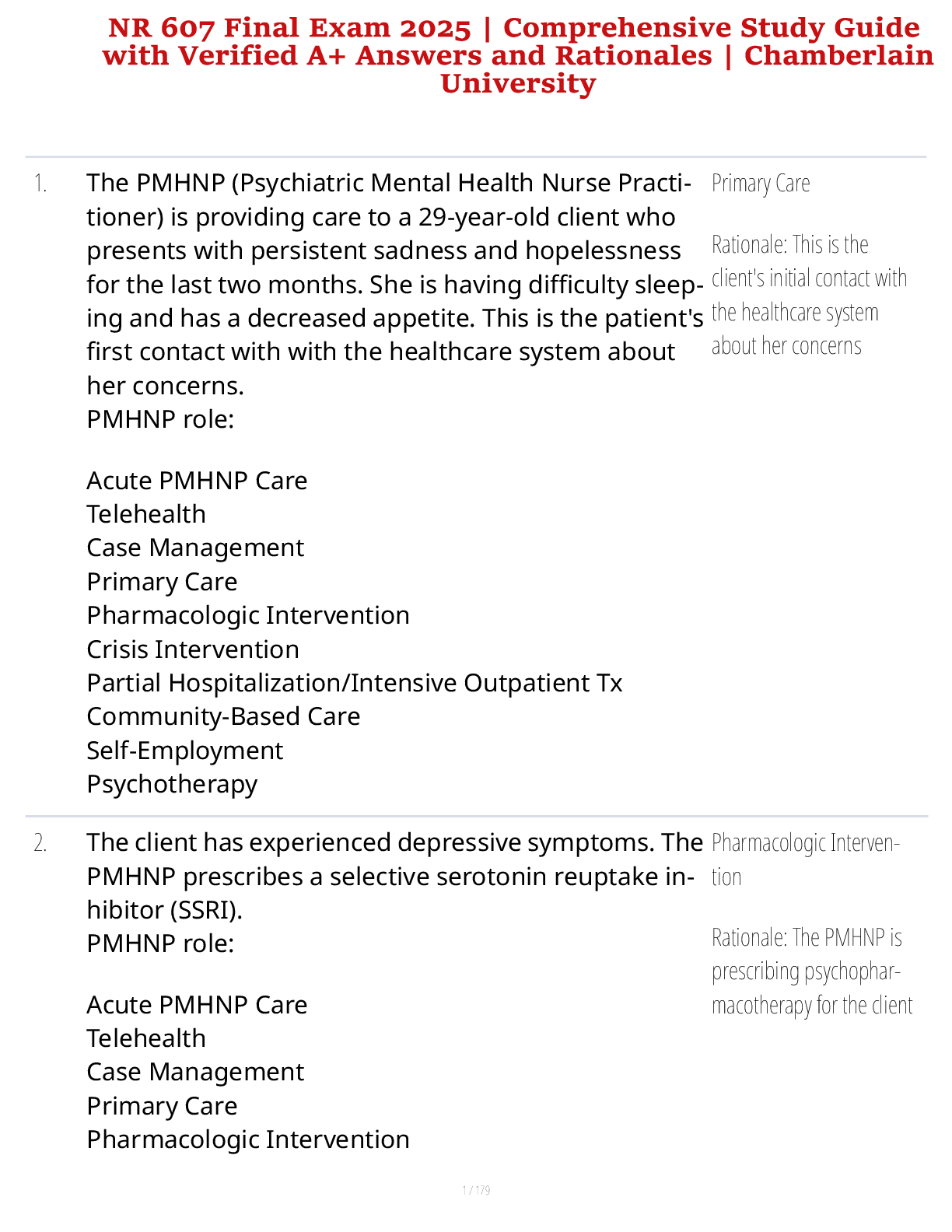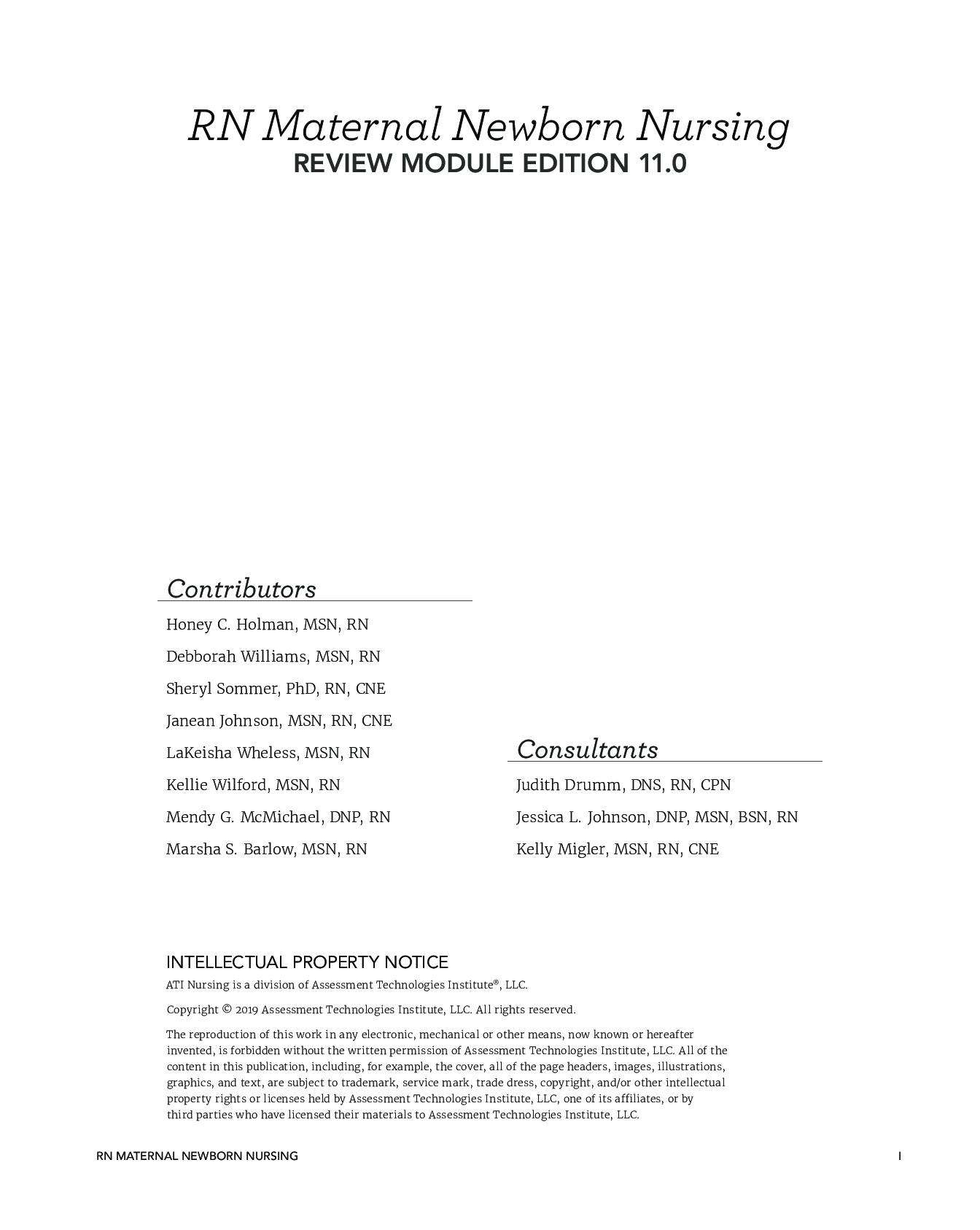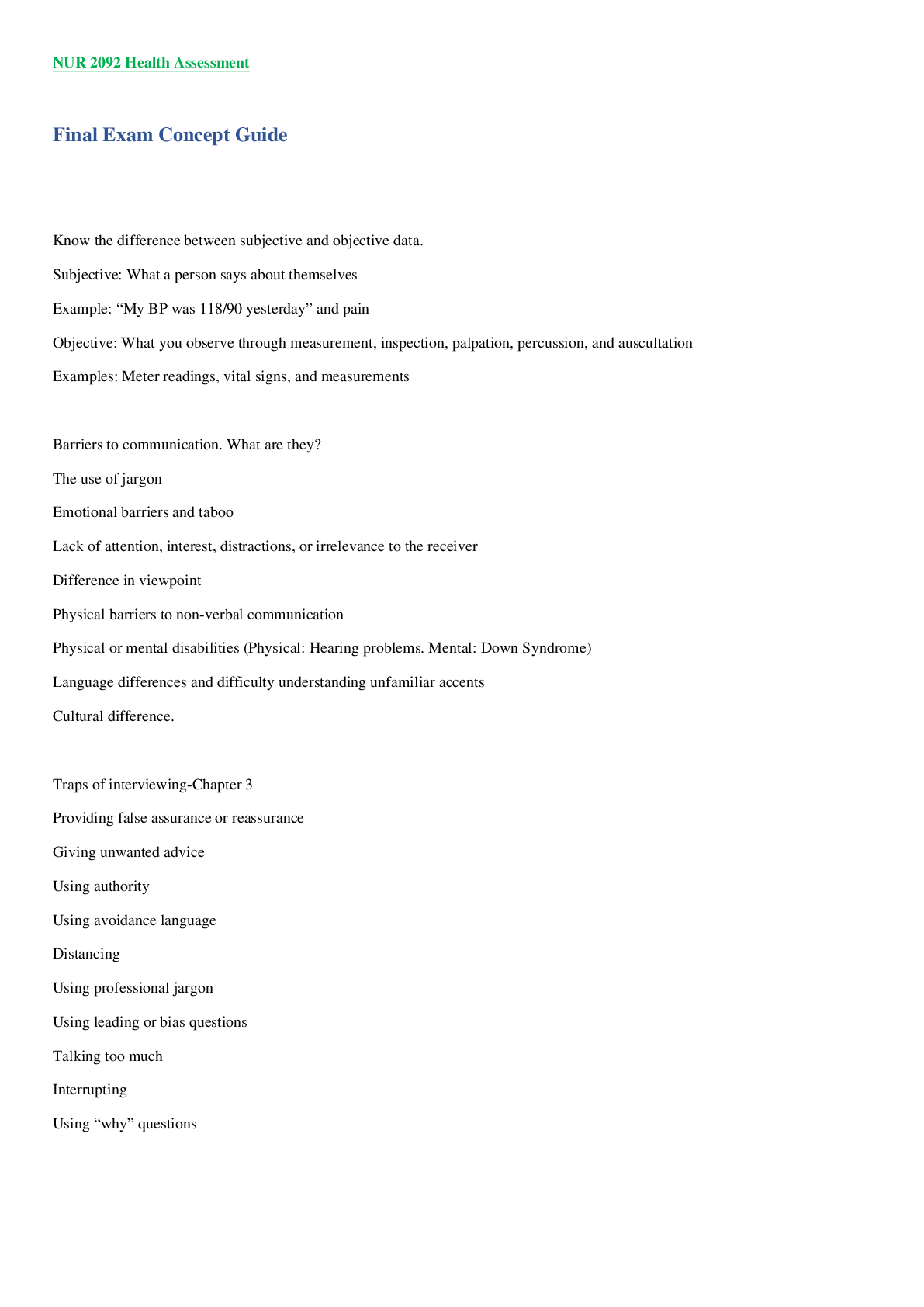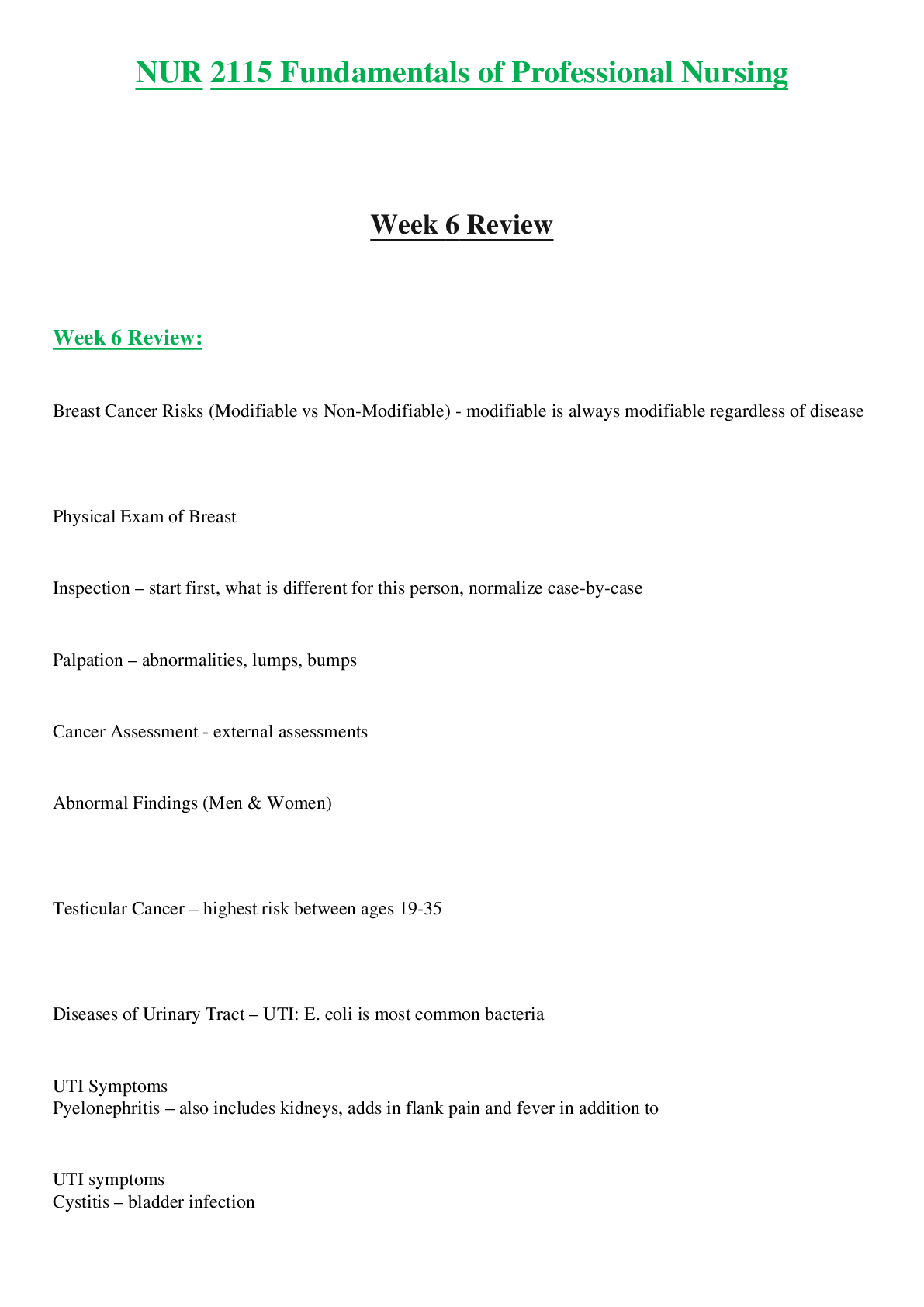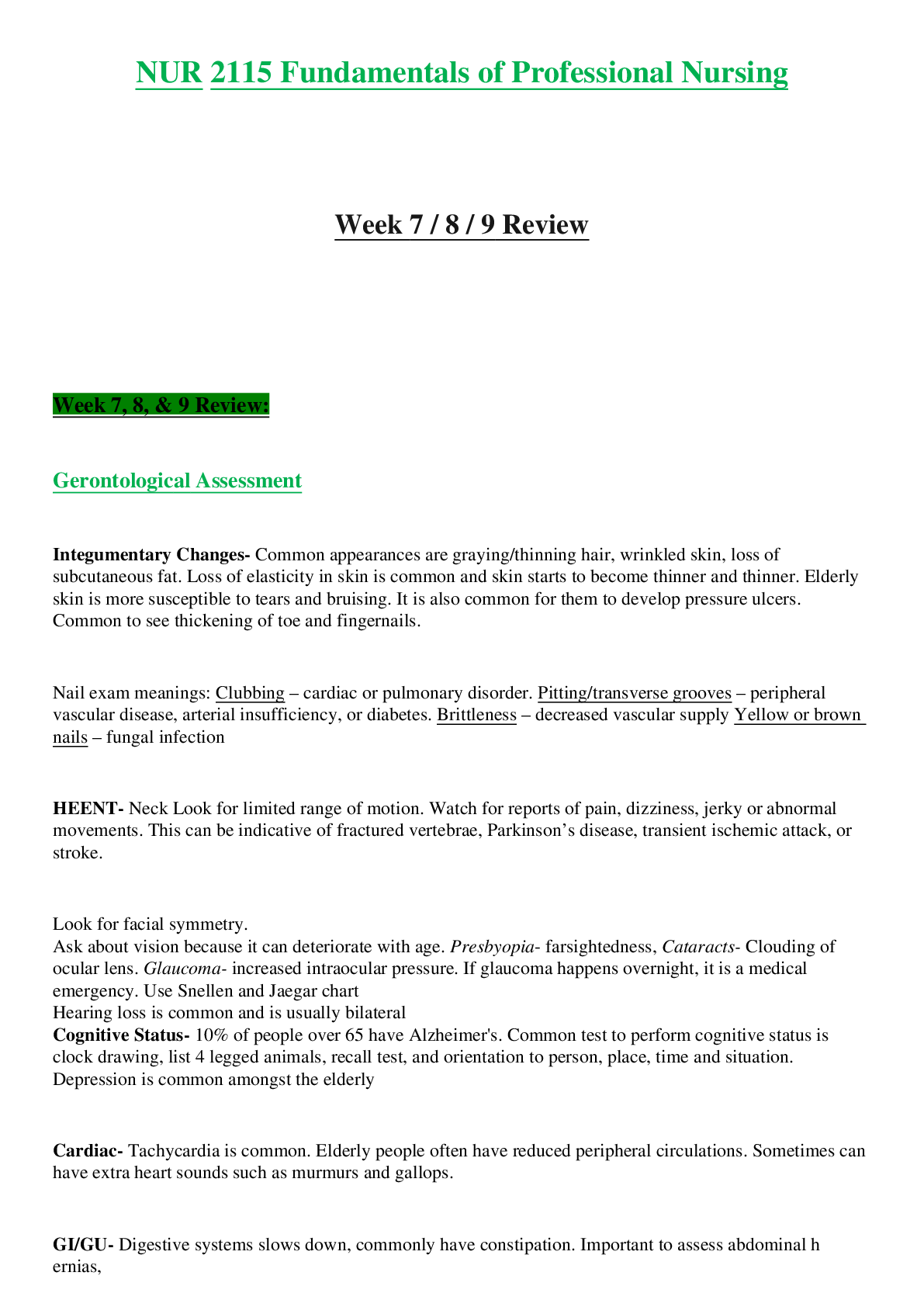*NURSING > STUDY GUIDE > LPN / LV Cardiovascular Heart Failure STUDY GUIDE | The document contains 360 Questions and Answers (All)
LPN / LV Cardiovascular Heart Failure STUDY GUIDE | The document contains 360 Questions and Answers.
Document Content and Description Below
Ch 34: Heart Failure/ Cardiovascular (BIG study guide) For LPN/LVN Te360 Questions and Answers 1. While assessing a 68-year- old with ascites, the nurse also notes jugular venous distention ( ... JVD) with the head of the patient's bed elevated 45 degrees. The nurse knows this finding indicates a. decreased fluid volume. b. jugular vein atherosclerosis. c. increased right atrial pressure. d. incompetent jugular vein valves. The jugular veins empty into the superior vena cava and then into the right atrium, so JVD with the patient sitting at a 45-degree angle reflects increased right atrial pressure. JVD is an indicator of excessive fluid volume (increased preload), not decreased fluid volume. JVD is not caused by incompetent jugular vein valves or atherosclerosis. 2. The nurse is caring for a patient who is receiving IV Because the patient's major clinical manifestation furosemide (Lasix) and of ADHF is orthopnea (caused by the presence of morphine for the treatment of fluid in the alveoli), the best indicator that the acute decompensated heart medications are effective is a decrease in dyspnea failure (ADHF) with severe with the head of the bed at 30 degrees. The other orthopnea. Which clinical assessment data also may indicate that diuresis or finding is the best indicator improvement in cardiac output has occurred, but that the treatment has been are not as specific to evaluating this patient's effective? response. a. Weight loss of 2 pounds in 24 hours b. Hourly urine output greater than 60 mL c. Reduction in patient complaints of chest pain d. Reduced dyspnea with the head of bed at 30 degrees 3. Which topic will the nurse plan to include in discharge The core measures for the treatment of heart teaching for a patient with failure established by The Joint Commission systolic heart failure and an indicate that patients with an ejection fraction (EF) ejection fraction of 33%? <40% receive an ACE inhibitor to decrease the a. Need to begin an aerobic progression of heart failure. Aerobic exercise may exercise program several not be appropriate for a patient with this level of times weekly heart failure, salt substitutes are not usually b. Use of salt substitutes to recommended because of the risk of replace table salt when hyperkalemia, and the patient will need to see the cooking and at the table primary care provider more frequently than c. Benefits and side effects of annually. angiotensin-converting enzyme (ACE) inhibitors d. Importance of making an annual appointment with the primary care provider 4. IV sodium nitroprusside (Nipride) is ordered for a Sodium nitroprusside is a potent vasodilator, and patient with acute pulmonary the major adverse effect is severe hypotension. edema. During the first hours Coughing and bradycardia are not adverse of administration, the nurse effects of this medication. Nitroprusside does not will need to titrate the cause increased ventricular ectopy. nitroprusside rate if the patient develops a. ventricular ectopy. b. a dry, hacking cough. c. a systolic BP <90 mm Hg. d. a heart rate <50 beats/minute. 5. A patient who has chronic heart failure tells the nurse, "I Paroxysmal nocturnal dyspnea is caused by the was fine when I went to bed, reabsorption of fluid from dependent body areas but I woke up in the middle of when the patient is sleeping and is characterized the night feeling like I was by waking up suddenly with the feeling of suffocating!" The nurse will suffocation. Pulsus alternans is the alternation of document this assessment strong and weak peripheral pulses during finding as palpation. Orthopnea indicates that the patient is a. orthopnea. unable to lie flat because of dyspnea. Pleural b. pulsus alternans. effusions develop over a longer time period. c. paroxysmal nocturnal dyspnea. d. acute bilateral pleural effusion. 6. During a visit to a 78-year- old with chronic heart failure, The patient's statement supports the diagnosis of the home care nurse finds activity intolerance. There are no data to support that the patient has ankle the other diagnoses, although the nurse will need edema, a 2-kg weight gain to assess for other patient problems. over the past 2 days, and complains of "feeling too tired to get out of bed." Based on these data, the best nursing diagnosis for the patient is a. activity intolerance related to fatigue. b. disturbed body image related to weight gain. c. impaired skin integrity related to ankle edema. d. impaired gas exchange related to dyspnea on exertion. 7. The nurse working on the heart failure unit knows that Teaching for a patient with heart failure includes teaching an older female information about the need to weigh daily and patient with newly diagnosed notify the health care provider about an increase heart failure is effective when of 3 pounds in 2 days or 3 to 5 pounds in a week. the patient states that Nitroglycerin patches are used primarily to a. she will take furosemide reduce preload (not to prevent chest pain) in (Lasix) every day at bedtime. patients with heart failure and should be used b. the nitroglycerin patch is daily, not on an "as needed" basis. Diuretics should applied when any chest pain be taken earlier in the day to avoid nocturia and develops. sleep disturbance. The patient should call the c. she will call the clinic if her clinic if increased orthopnea develops, rather than weight goes from 124 to 128 just compensating by further elevating the head pounds in a week. of the bed. d. an additional pillow can help her sleep if she is feeling short of breath at night. 8. When teaching the patient with newly diagnosed heart failure about a 2000-mg sodium diet, the nurse explains that foods to be restricted include a. canned and frozen fruits. b. fresh or frozen vegetables. c. eggs and other high- protein foods. d. milk, yogurt, and other milk products. Milk and yogurt naturally contain a significant amount of sodium, and intake of these should be limited for patients on a diet that limits sodium to 2000 mg daily. Other milk products, such as processed cheeses, have very high levels of sodium and are not appropriate for a 2000-mg sodium diet. The other foods listed have minimal levels of sodium and can be eaten without restriction. 9. The nurse plans discharge teaching for a patient with Nausea is an indication of digoxin toxicity and chronic heart failure who has should be reported so that the provider can prescriptions for digoxin assess the patient for toxicity and adjust the (Lanoxin) and digoxin dose, if necessary. The patient will need to hydrochlorothiazide include potassium-containing foods in the diet to (HydroDIURIL). Appropriate avoid hypokalemia. Patients should be taught to instructions for the patient check their pulse daily before taking the digoxin include and if the pulse is less than 60, to call their a. limit dietary sources of provider before taking the digoxin. Diuretics potassium. should be taken early in the day to avoid sleep b. take the disruption. hydrochlorothiazide before bedtime. c. notify the health care provider if nausea develops. d. skip the digoxin if the pulse is below 60 beats/minute. 10. While admitting an 82- year-old with acute The data about the patient suggest that assistance decompensated heart failure in developing a system for taking medications to the hospital, the nurse correctly at home is needed. A home health nurse learns that the patient lives will assess the patient's home situation and help alone and sometimes the patient develop a method for taking the two confuses the "water pill" with medications as directed. There is no evidence that the "heart pill." When the patient requires services such as a planning for the patient's psychologist consult, long-term care, or around- discharge the nurse will the-clock home care. facilitate a a. consult with a psychologist. b. transfer to a long-term care facility. c. referral to a home health care agency. d. arrangements for around- the-clock care. 11. Following an acute myocardial infarction, a ACE inhibitor therapy is currently recommended previously healthy 63-year- to prevent the development of heart failure in old develops clinical patients who have had a myocardial infarction and manifestations of heart failure. as a first-line therapy for patients with chronic The nurse anticipates heart failure. Digoxin therapy for heart failure is no discharge teaching will longer considered a first-line measure, and include information about digoxin is added to the treatment protocol when a. digitalis preparations. therapy with other medications such as ACE- b. -adrenergic blockers. inhibitors, diuretics, and -adrenergic blockers is c. calcium channel blockers. insufficient. Calcium channel blockers are not d. angiotensin-converting generally used in the treatment of heart failure. enzyme (ACE) inhibitors. The -adrenergic blockers are not used as initial therapy for new onset heart failure. 12. A 53-year-old patient with Stage D heart failure and type 2 diabetes asks the nurse whether heart transplant is a possible therapy. Which response by the nurse is most appropriate? a. "Because you have diabetes, you would not be a candidate for a heart transplant." b. "The choice of a patient for a heart transplant depends on many different factors." c. "Your heart failure has not reached the stage in which heart transplants are needed." d. "People who have heart transplants are at risk for multiple complications after surgery." Indications for a heart transplant include end- stage heart failure (Stage D), but other factors such as coping skills, family support, and patient motivation to follow the rigorous posttransplant regimen are also considered. Diabetic patients who have well-controlled blood glucose levels may be candidates for heart transplant. Although heart transplants can be associated with many complications, this response does not address the patient's question. 13. Which diagnostic test will be most useful to the nurse in determining whether a patient admitted with acute shortness of breath has heart failure? a. Serum troponin b. Arterial blood gases c. B-type natriuretic peptide d. 12-lead electrocardiogram B-type natriuretic peptide (BNP) is secreted when ventricular pressures increase, as they do with heart failure. Elevated BNP indicates a probable or very probable diagnosis of heart failure. A twelve-lead electrocardiogram, arterial blood gases, and troponin may also be used in determining the causes or effects of heart failure but are not as clearly diagnostic of heart failure as BNP. 14. Which action should the nurse include in the plan of Nesiritide is a potent arterial and venous dilator, care when caring for a patient and the major adverse effect is hypotension. admitted with acute Because the patient is likely to have orthostatic decompensated heart failure hypotension, the patient should not be (ADHF) who is receiving encouraged to ambulate. Nesiritide does not nesiritide (Natrecor)? require titration and is used for ADHF but not in a a. Monitor blood pressure home setting. frequently. b. Encourage patient to ambulate in room. c. Titrate nesiritide slowly before stopping. d. Teach patient about home use of the drug. 15. A patient with heart failure has a new order for captopril Captopril can cause hypotension, especially after (Capoten) 12.5 mg PO. After the initial dose, so it is important that the patient administering the first dose not get up out of bed without assistance until the and teaching the patient nurse has had a chance to evaluate the effect of about the drug, which the first dose. The angiotensin-converting enzyme statement by the patient (ACE) inhibitors are potassium sparing, and the indicates that teaching has nurse should not teach the patient to purposely been effective? increase sources of dietary potassium. Increased a. "I will be sure to take the shortness of breath is expected with the initiation medication with food." of -adrenergic blocker therapy for heart failure, b. "I will need to eat more not for ACE inhibitor therapy. ACE inhibitors are potassium-rich foods in my best absorbed when taken an hour before eating. diet." c. "I will call for help when I need to get up to use the bathroom." d. "I will expect to feel more short of breath for the next few days." 16. A patient who has just been admitted with pulmonary edema is scheduled to receive the following medications. Which medication should the nurse question before giving? a. Furosemide (Lasix) 60 mg b. Captopril (Capoten) 25 mg c. Digoxin (Lanoxin) 0.125 mg d. Carvedilol (Coreg) 3.125 mg Although carvedilol is appropriate for the treatment of chronic heart failure, it is not used for patients with acute decompensated heart failure (ADHF) because of the risk of worsening the heart failure. The other medications are appropriate for the patient with ADHF. 17. A patient with a history of chronic heart failure is This patient's severe dyspnea and cough indicate admitted to the emergency that acute decompensated heart failure (ADHF) is department (ED) with severe occurring. ADHF usually manifests as pulmonary dyspnea and a dry, hacking edema, which should be detected and treated cough. Which action should immediately to prevent ongoing hypoxemia and the nurse do first? cardiac/respiratory arrest. The other assessments a. Auscultate the abdomen. will provide useful data about the patient's volume b. Check the capillary refill. status and also should be accomplished rapidly, c. Auscultate the breath but detection (and treatment) of pulmonary sounds. complications is the priority. d. Assess the level of orientation. 18. A patient with chronic heart failure who is taking a diuretic and an angiotensin- converting enzyme (ACE) inhibitor and who is on a low- sodium diet tells the home health nurse about a 5-pound weight gain in the last 3 days. The nurse's priority action will be to a. have the patient recall the dietary intake for the last 3 days. b. ask the patient about the use of the prescribed medications. c. assess the patient for clinical manifestations of acute heart failure. d. teach the patient about the importance of restricting dietary sodium. The 5-pound weight gain over 3 days indicates that the patient's chronic heart failure may be worsening. It is important that the patient be assessed immediately for other clinical manifestations of decompensation, such as lung crackles. A dietary recall to detect hidden sodium in the diet, reinforcement of sodium restrictions, and assessment of medication compliance may be appropriate interventions but are not the first nursing actions indicated. 19. A patient in the intensive care unit with acute decompensated heart failure (ADHF) complains of severe dyspnea and is anxious, tachypneic, and tachycardic. All of the following medications have been ordered for the patient. The nurse's priority action will be to a. give IV morphine sulfate 4 mg. b. give IV diazepam (Valium) 2.5 mg. c. increase nitroglycerin (Tridil) infusion by 5 mcg/min. d. increase dopamine (Intropin) infusion by 2 mcg/kg/min. Morphine improves alveolar gas exchange, improves cardiac output by reducing ventricular preload and afterload, decreases anxiety, and assists in reducing the subjective feeling of dyspnea. Diazepam may decrease patient anxiety, but it will not improve the cardiac output or gas exchange. Increasing the dopamine may improve cardiac output, but it will also increase the heart rate and myocardial oxygen consumption. Nitroglycerin will improve cardiac output and may be appropriate for this patient, but it will not directly reduce anxiety and will not act as quickly as morphine to decrease dyspnea. 20. After receiving change-of- shift report on a heart failure The patient who has "wet-cold" clinical unit, which patient should the manifestations of heart failure is perfusing nurse assess first? inadequately and needs rapid assessment and a. A patient who is cool and changes in management. The other patients also clammy, with new-onset should be assessed as quickly as possible but do confusion and restlessness not have indications of severe decreases in tissue b. A patient who has crackles perfusion. bilaterally in the lung bases and is receiving oxygen. c. A patient who had dizziness after receiving the first dose of captopril (Capoten) d. A patient who is receiving IV nesiritide (Natrecor) and has a blood pressure of 100/62 21. Which assessment finding in a patient admitted with acute decompensated heart failure (ADHF) requires the most immediate action by the nurse? a. Oxygen saturation of 88% b. Weight gain of 1 kg (2.2 lb) c. Heart rate of 106 beats/minute d. Urine output of 50 mL over 2 hours A decrease in oxygen saturation to less than 92% indicates hypoxemia. The nurse should administer supplemental oxygen immediately to the patient. An increase in apical pulse rate, 1-kg weight gain, and decreases in urine output also indicate worsening heart failure and require nursing actions, but the low oxygen saturation rate requires the most immediate nursing action. 22. A patient has recently started on digoxin (Lanoxin) Hypokalemia can predispose the patient to life- in addition to furosemide threatening dysrhythmias (e.g., premature (Lasix) and captopril ventricular contractions), and potentiate the (Capoten) for the actions of digoxin and increase the risk for digoxin management of heart failure. toxicity, which can also cause life-threatening Which assessment finding by dysrhythmias. The other data indicate that the the home health nurse is a patient's heart failure requires more effective priority to communicate to therapies, but they do not require nursing action the health care provider? as rapidly as the low serum potassium level. a. Presence of 1 to 2+ edema in the feet and ankles b. Palpable liver edge 2 cm below the ribs on the right side c. Serum potassium level 3.0 mEq/L after 1 week of therapy d. Weight increase from 120 pounds to 122 pounds over 3 days 23. An outpatient who has chronic heart failure returns The patient's BP indicates that the dose of to the clinic after 2 weeks of metoprolol may need to be decreased because therapy with metoprolol of hypotension. Bradycardia is a frequent adverse (Toprol XL). Which assessment effect of -adrenergic blockade, but the rate of 56 finding is most important for is not unusual with â-adrenergic blocker therapy. - the nurse to report to the Adrenergic blockade initially will worsen health care provider? symptoms of heart failure in many patients, and a. 2+ pedal edema patients should be taught that some increase in b. Heart rate of 56 symptoms, such as fatigue and edema, is beats/minute expected during the initiation of therapy with this c. Blood pressure (BP) of class of drugs. 88/42 mm Hg d. Complaints of fatigue 24. A patient who is receiving dobutamine (Dobutrex) for the treatment of acute decompensated heart failure (ADHF) has the following nursing interventions included in the plan of care. Which action will be most appropriate for the registered nurse (RN) to delegate to an experienced licensed practical/vocational nurse An experienced LPN/LVN would be able to monitor BP and heart rate and would know to report significant changes to the RN. Teaching patients, making adjustments to the drip rate for vasoactive medications, and monitoring for serious complications such as extravasation require RN level education and scope of practice. (LPN LVN)? a. Assess the IV insertion site for signs of extravasation. b. Teach the patient the reasons for remaining on bed rest. c. Monitor the patient's blood pressure and heart rate every hour. d. Titrate the rate to keep the systolic blood pressure >90 mm Hg. 25. After receiving change-of- shift report on a heart failure unit, which patient should the nurse assess first? a. Patient who is taking carvedilol (Coreg) and has a heart rate of 58 b. Patient who is taking digoxin and has a potassium level of 3.1 mEq/L c. Patient who is taking isosorbide dinitrate/hydralazine (BiDil) and has a headache d. Patient who is taking captopril (Capoten) and has a frequent nonproductive cough The patient's low potassium level increases the risk for digoxin toxicity and potentially fatal dysrhythmias. The nurse should assess the patient for other signs of digoxin toxicity and then notify the health care provider about the potassium level. The other patients also have side effects of their medications, but their symptoms do not indicate potentially life-threatening complications. 1. Based on the Joint , C, D, E Commission Core Measures The Joint Commission Core Measures state that for patients with heart failure, patients should be taught about prescribed which topics should the nurse medications, follow-up appointments, weight include in the discharge monitoring, and actions to take for worsening teaching plan for a patient symptoms. Patients with heart failure are who has been hospitalized encouraged to begin or continue aerobic with chronic heart failure exercises such as walking, while self-monitoring to (select all that apply)? avoid excessive fatigue. a. How to take and record daily weight b. Importance of limiting aerobic exercise c. Date and time of follow-up appointment d. Symptoms indicating worsening heart failure e. Actions and side effects of prescribed medications 2.A client is diagnosed with heart failure. Which of the following diagnostic tests is useful to determine the degree of the failure? 1. Brain natriuretic peptide level 2. Blood cultures 3. Sedimentation rate 4. Arterial blood gas ANS: 1 Brain natriuretic peptide is a hormone found in the left ventricle; it is used to help diagnose and grade the severity of heart failure. Blood cultures are used to diagnose carditis. Sedimentation rate is used to diagnose pericarditis. Arterial blood gasses are not used to determine the degree of heart failure. 3.A nurse is instructing a client regarding medications and substances contraindicated for the client with heart failure. Which of the following would not be contraindicated? 1. Alcohol 2. Furosemide 3. Metformin 4. Pioglitazone ANS: 2 Loop diuretics (e.g., furosemide) are part of the recommended medications for heart failure. Alcohol, metformin, and pioglitazone (a thiazolidinedione) are contraindicated. 4.The nurse is determining ANS: 3 nursing diagnoses The first priority is to maintain adequate appropriate for a client oxygenation. The next diagnoses in priority would demonstrating productive be risk for ineffective cough with respiratory function. Activity intolerance would be pink frothy sputum, shortness the third diagnosis. Anxiety would be the last of breath, and crackles. Which diagnosis of the following nursing in order of priority. diagnoses is of the most importance? 1. Activity intolerance 2. Anxiety 3. Impaired gas exchange 4. Risk for ineffective respiratory function 5.In planning the care for a client diagnosed with heart failure, which of the following would be an appropriate goal? 1. Reduce myocardial contractility. 2. Increase cardiac workload. 3. Decrease ejection fraction. 4. Increase activity levels. ANS: 4 An increase in activity levels would be an appropriate goal for the client diagnosed with heart failure. The other options would be a decrease in ability, function, or management of the heart failure patient. PTS: 1 DIF: Analyze REF: Heart Failure: Collaborative Management 6.The nurse is instructing a client diagnosed with mild heart failure on dietary modifications. Which of the following client statements indicates that the instruction has been effective? 1. "I will avoid green beans." 2. "I will avoid orange juice." 3. "I will avoid soy sauce." 4. "I will avoid apple sauce." ANS: 3 Soy sauce is a high-sodium food choice; all the other choices are low sodium. Treatment for mild symptoms of heart failure includes dietary restriction of salt. 7.A client is undergoing diagnostic testing for infective endocarditis. Which of the following laboratory tests would be most useful in diagnosis? 1. Basic metabolic panel 2. Blood cultures 3. Reticulocyte count 4. Prothrombin time ANS: 2 Blood cultures identify the causative organisms. A basic metabolic panel gives the current status of the client's acid/base balance and electrolytes. The reticulocyte count determines bone marrow function and evaluates erythropoietic activity. The prothrombin time is useful in monitoring anticoagulant therapy. 8.Which of the following would the nurse most likely assess in a client diagnosed with right-sided heart failure? 1. Distended neck veins 2. Oliguria 3. Cough with frothy blood- tinged sputum 4. Syncope ANS: 1 An assessment finding in a client diagnosed with right-sided heart failure is distended neck veins. Oliguria, cough with frothy blood-tinged sputum, and syncope are all clinical manifestations of left- sided heart failure. 9.Which of the following diagnostic tests is useful to diagnose mitral valve prolapse? 1. Electrocardiogram 2. Echocardiogram 3. Cardiac angiography 4. Transesophageal echocardiography ANS: 4 Transesophageal echocardiography is useful in the assessment of cardiac murmurs, stenosis, and regurgitation of all four cardiac valves. An electrocardiogram, echocardiogram, and cardiac angiography may or may not be useful when diagnosing mitral valve prolapse. 10.A client diagnosed with mitral valve prolapse is experiencing palpitations. Which of the following should the nurse instruct this client? 1. Avoid tobacco 2. Ingest alcohol in moderation 3. Avoid weight loss 4. Limit caffeine intake ANS: 1 Clients with palpitations associated with mitral valve prolapse should be instructed to avoid caffeine, alcohol, and tobacco. Weight loss should be encouraged in overweight clients. 11.A client tells the nurse that she had rheumatic heart disease as a child. For which of the following valvular disorders should this client be assessed? 1. Mitral valve prolapse 2. Mitral stenosis 3. Aortic regurgitation 4. Aortic stenosis ANS: 2 Mitral stenosis is most commonly caused by rheumatic heart disease. Rheumatic heart disease has not been linked to mitral valve prolapse, aortic regurgitation, or aortic stenosis. 12.A client, recovering from surgery to replace a calcified aortic valve with a mechanical valve, should be instructed that which of the following medications will be needed long term? 1. ACE inhibitor 2. Beta-blocker 3. Antibiotic 4. Anticoagulant ANS: 4 The mechanical valve requires long-term anticoagulation therapy to prevent the risk of thromboembolism. ACE inhibitors, beta-blockers, and antibiotics are not indicated as long-term therapy for this surgery. 13.A client is scheduled for annuloplasty surgery to the aortic valve. Which of the following will most likely occur during this client's procedure? 1. A catheter will be inserted through the femoral vein. 2. A heart bypass machine will be used. 3. Local anesthesia will be provided. 4. A balloon will inflate and stretch the valve open. ANS: 2 For an annuloplasty, the client will receive general anesthesia and a heart bypass machine will be used. A balloon valvuloplasty is done by inserting a catheter through the femoral vein or artery and stretching the valve open with a balloon. The client needs general anesthesia for an annuloplasty and not a local anesthetic. 1.The nurse suspects a client is experiencing left-sided heart failure when which of the following is assessed? (Select all that apply.) 1. Decreased basilar lung sounds 2. Distended neck veins 3. Extra heart sounds 4. Lung crackles 5. Tachycardia 6. Weight gain ANS: 1, 3, 4, 5 Signs of left-sided heart failure are dysrhythmic heart rate, tachycardia, heart murmurs, extra heart sounds, lung crackles, and decreased basilar lung sounds. Distended neck veins and weight gain are symptoms of rightsided heart failure. 2.A client diagnosed with heart failure is prescribed furosemide (Lasix). Which of the following should this client be monitored for because of this medication? (Select all that apply.) 1. Dehydration 2. Rebound fluid volume overload 3. Hyponatremia 4. Hypokalemia 5. Hypernatremia 6. Hyperkalemia ANS: 1, 3, 4 Any client prescribed diuretics should be monitored for dehydration, hyponatremia, and hypokalemia. Rebound fluid volume overload is not possible with diuretic therapy. Hypernatremia and hyperkalemia are also not possible with diuretic therapy. 3.The nurse is reviewing the medications prescribed for a client diagnosed with dilated cardiomyopathy. Which of the following medications are commonly prescribed for this disease process? (Select all that apply.) 1. ACE Inhibitor 2. Beta-blocker 3. Diuretic 4. Anticoagulant 5. Antiarrhythmic 6. Antibiotic ANS: 1, 2, 3, 4, 5 Pharmacological management of dilated cardiomyopathy includes ACE inhibitor to prevent further dilation of the heart, beta-blocker to reduce the strain that heart failure produces on the heart muscle, diuretics to decrease the amount of circulating fluid, anticoagulants to decrease blood clots, and antiarrhythmics to maintain the normal electrical stimulation of the heart. Antibiotics are not routinely prescribed for a client diagnosed with dilated cardiomyopathy. 4.Which of the following should the nurse instruct a client diagnosed with hypertrophic cardiomyopathy? (Select all that apply.) 1. Follow recommended activity level 2. Avoid all alcohol 3. Take hot tub baths routinely 4. Avoid overexertion 5. Avoid dehydration 6. Unexplained breathlessness is a common symptom ANS: 1, 4, 5 The nurse should instruct the client diagnosed with hypertrophic cardiomyopathy to follow the recommended activity level, avoid overexertion, and avoid dehydration. The client should be instructed to use alcohol in moderation, to avoid hot tub baths or showers, and to report unexplained breathlessness to a health care provider. 5.The nurse determines that a client diagnosed with pericarditis is demonstrating the classic signs of the Beck triad. What are the signs of the Beck triad? (Select all that apply.) 1. Fever 2. Dyspnea 3. Muffled heart sounds 4. Elevated jugular vein pressure 5. Hypotension 6. Abdominal pain ANS: 3, 4, 5 The symptoms of Beck triad include muffled heart sounds, elevated jugular vein pressure, and hypotension. Fever, dyspnea, and abdominal pain are not considered findings within the Beck triad. 1. A nurse performs an apical- radial pulse evaluation, with the result of 100/88. What is the pulse deficit? a. 12 b. 24 c. 76 d. 88 To detect an apical-radial pulse deficit, the rates should be counted simultaneously and compared for differences. If a difference exists between the apical rate and the radial rate, then a pulse deficit is present. For example, in atrial fibrillation, a pulse deficit exists. 2. What is increased in hypertension that in turn causes an increase in the work of the heart? a. Preload b. Stroke volume c. Contractility d. Afterload ********************************** CONTINUED IN THE ATTACHMENT *********************************** [Show More]
Last updated: 1 year ago
Preview 5 out of 65 pages

Loading document previews ...
Buy this document to get the full access instantly
Instant Download Access after purchase
Buy NowInstant download
We Accept:

Reviews( 0 )
$9.00
Can't find what you want? Try our AI powered Search
Document information
Connected school, study & course
About the document
Uploaded On
Apr 01, 2021
Number of pages
65
Written in
All
Additional information
This document has been written for:
Uploaded
Apr 01, 2021
Downloads
0
Views
156

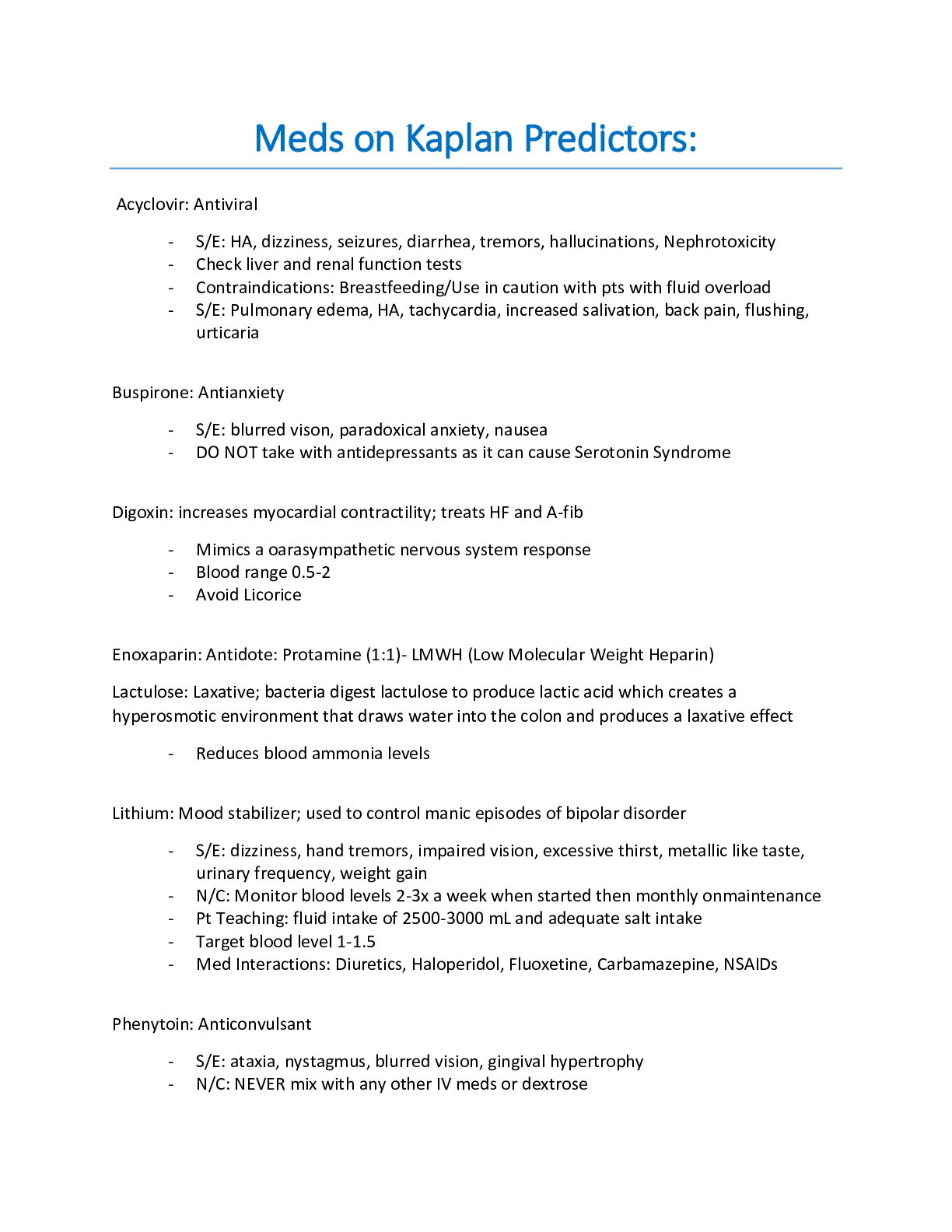
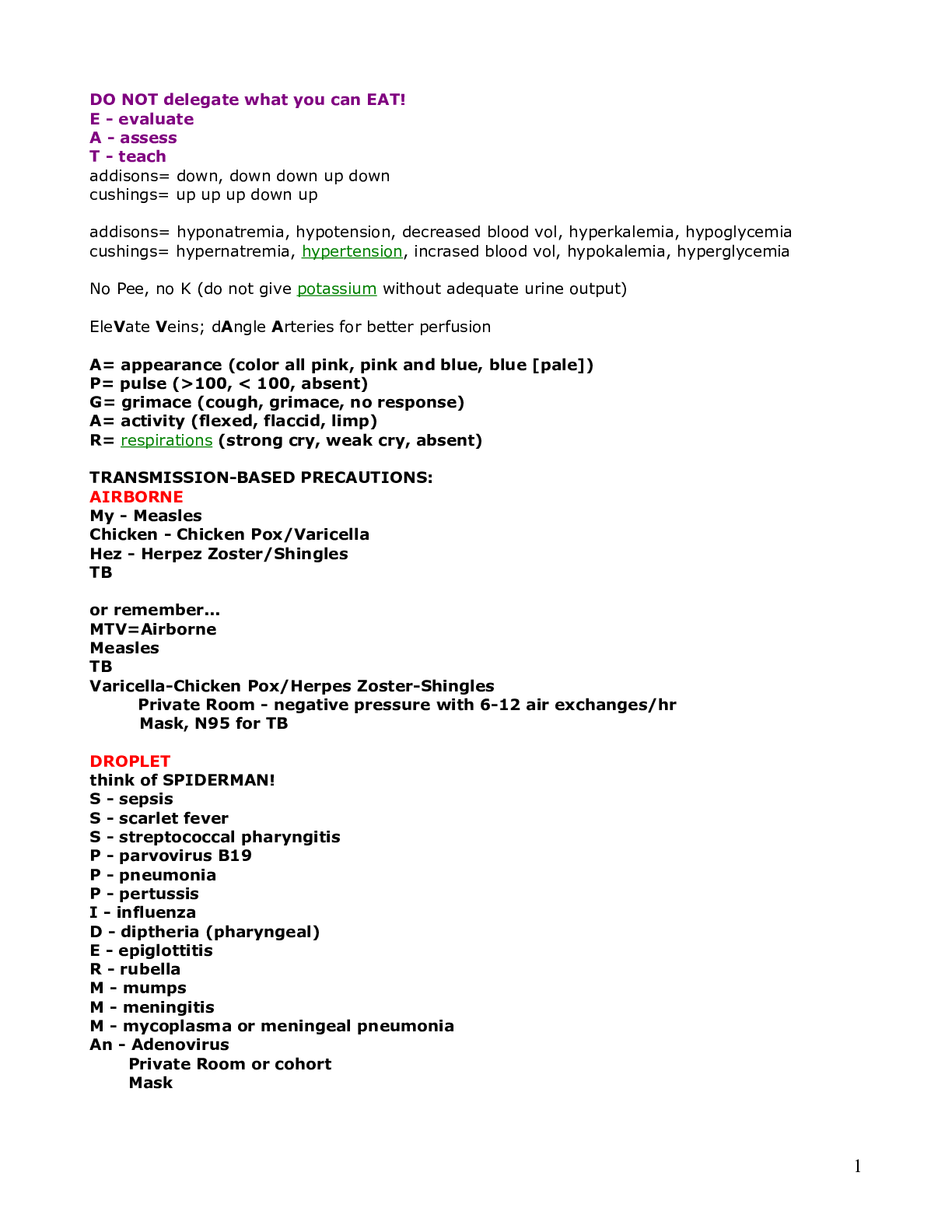
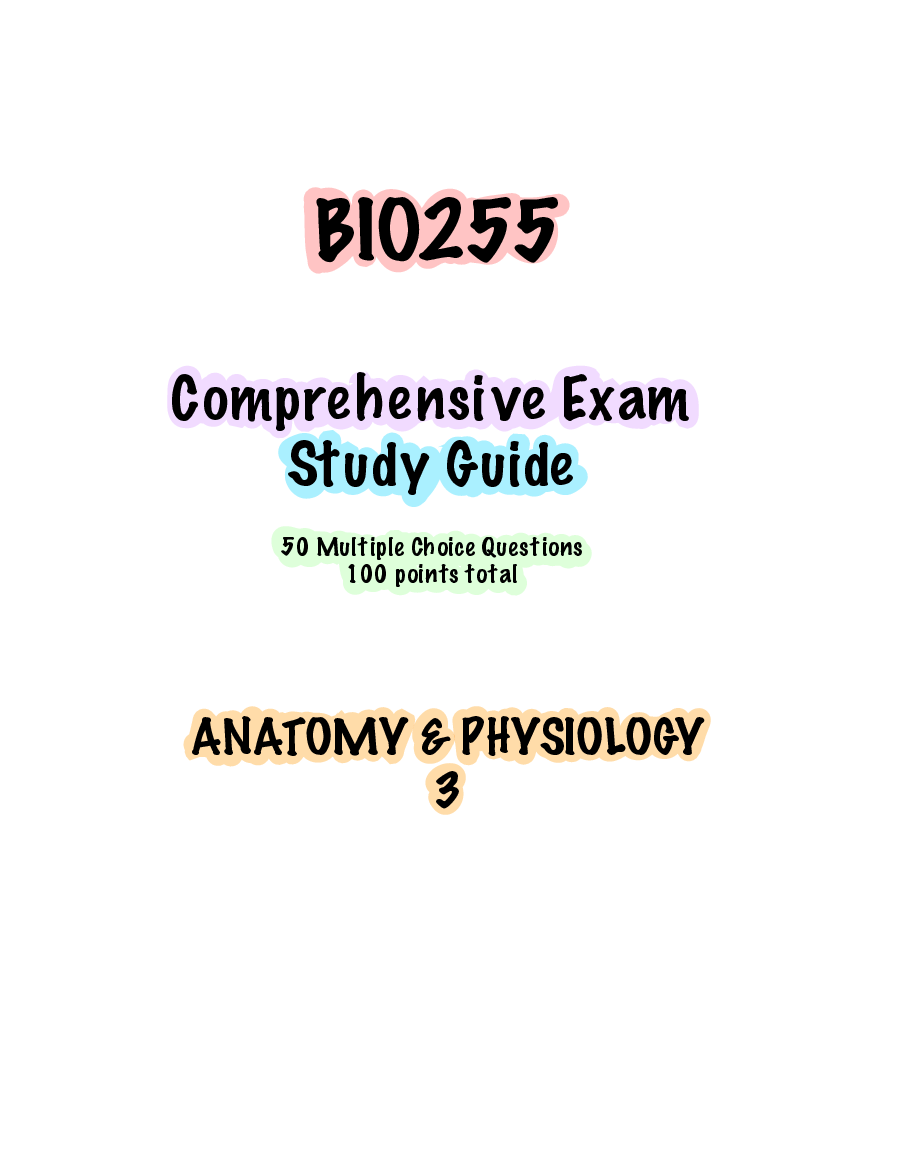
.png)
